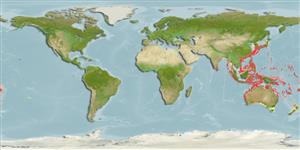Common names from other countries
Environment: milieu / climate zone / depth range / distribution range
Écologie
marin démersal; profondeur 85 - 154 m (Ref. 9824). Temperate
Indo-West Pacific: southern Japan to the South China Sea. Also recorded from northwestern Australia (Ref. 5978) and New Caledonia (Ref. 9824).
Taille / Poids / Âge
Maturity: Lm ? range ? - ? cm
Max length : 17.0 cm TL mâle / non sexé; (Ref. 9824)
Épines dorsales (Total) : 0; Rayons mous dorsaux (Total) : 99 - 106; Épines anales: 0; Rayons mous anaux: 76 - 83. Snout sharp. Maxillary extending to below or beyond middle of lower eye. No gill rakers on upper limb. Cycloid scales on ocular side. Caudal fin having 3 simple upper and lower rays. No dark blotch on pectoral and pelvic fins. Second dorsal fin ray elongated in male.
Inhabits bottoms with broken coral, shell, pebbles, and gray mud. Feeds on bottom-living animals.
Life cycle and mating behavior
Maturities | Reproduction | Spawnings | Egg(s) | Fecundities | Larves
Masuda, H., K. Amaoka, C. Araga, T. Uyeno and T. Yoshino, 1984. The fishes of the Japanese Archipelago. Vol. 1. Tokai University Press, Tokyo, Japan. 437 p. (text). (Ref. 559)
Statut dans la liste rouge de l'IUCN (Ref. 130435)
CITES (Ref. 128078)
Not Evaluated
Menace pour l'homme
Harmless
Utilisations par l'homme
Pêcheries: sans intérêt
Outils
Articles particuliers
Télécharger en XML
Sources Internet
Estimates based on models
Preferred temperature (Ref.
115969): 15.3 - 26.8, mean 21.2 (based on 167 cells).
Phylogenetic diversity index (Ref.
82804): PD
50 = 0.5000 [Uniqueness, from 0.5 = low to 2.0 = high].
Bayesian length-weight: a=0.00759 (0.00394 - 0.01459), b=3.03 (2.86 - 3.20), in cm Total Length, based on LWR estimates for this species & (Sub)family-body (Ref.
93245).
Niveau trophique (Ref.
69278): 3.5 ±0.37 se; based on food items.
Résilience (Ref.
120179): Milieu, temps minimum de doublement de population : 1,4 à 4,4 années (Preliminary K or Fecundity.).
Fishing Vulnerability (Ref.
59153): Low vulnerability (10 of 100).
